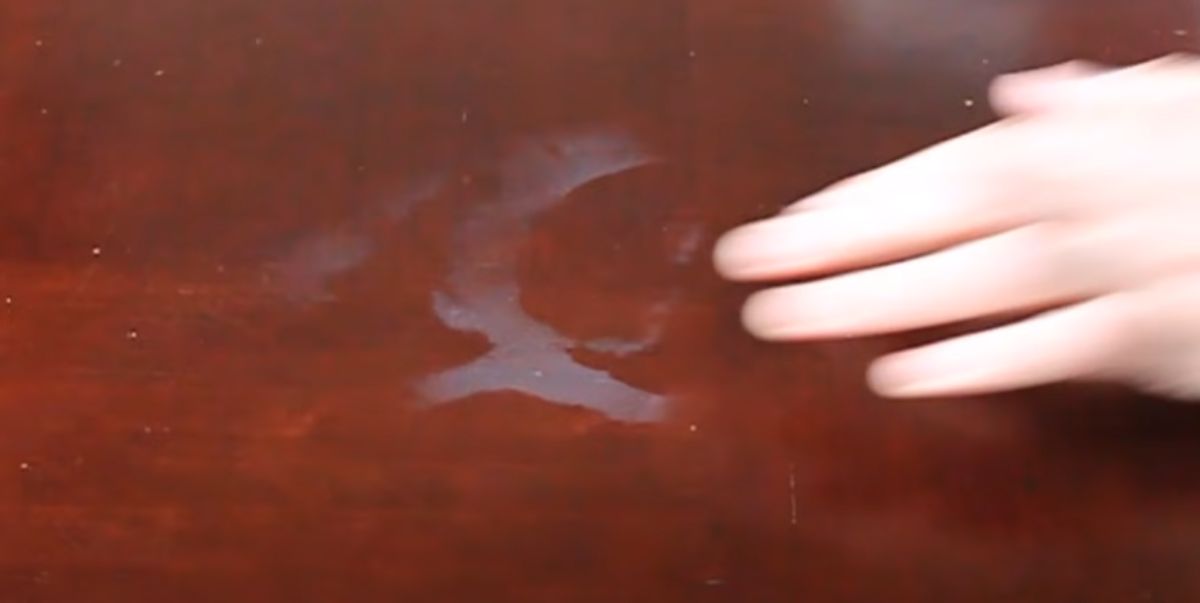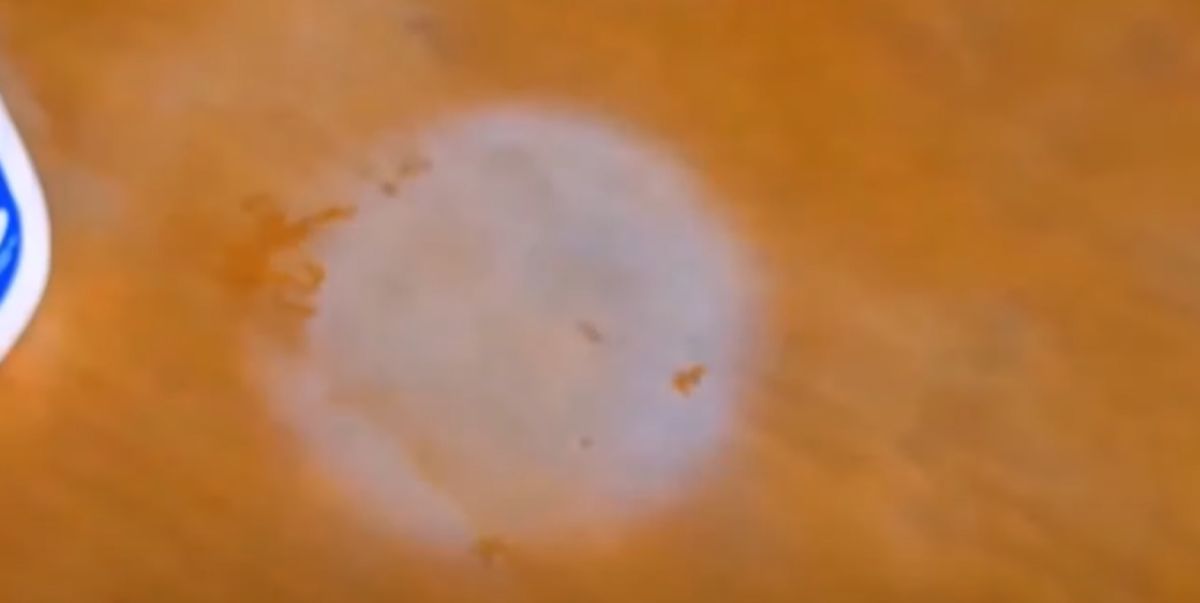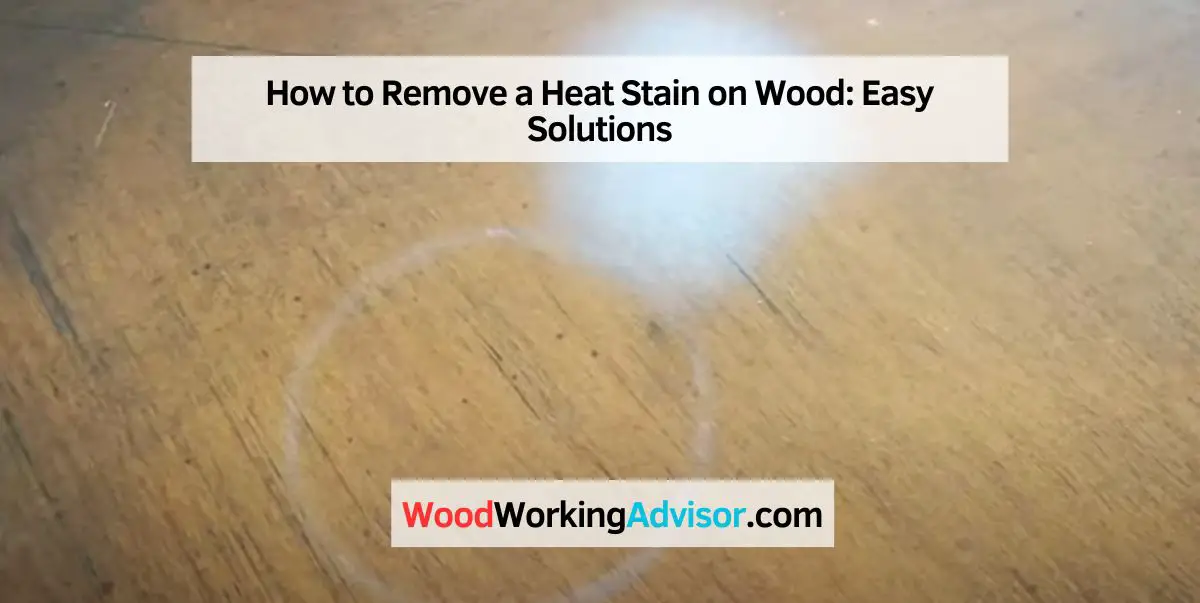To fix a heat stain on wood, use a mixture of baking soda and water and gently rub it onto the stain.
Identifying The Heat Stain
To identify a heat stain on wood, first, look for a discolored or darkened area on the surface. Then, gently feel the affected area for any roughness or irregular texture, which indicates the presence of the heat stain. If the stain is shallow, it can be easily fixed using simple DIY methods.
Recognizing The Types Of Heat Stains
When it comes to fixing a heat stain on wood, the first step is to identify the type of heat stain you’re dealing with. There are two common types of heat stains that can occur on wood surfaces: white and black stains. Recognizing these stains is crucial because the treatment options can vary.
➡️ White Stains:
White stains are typically caused by hot objects like mugs or dishes that leave behind moisture on the wood surface. These stains appear as cloudy or milky areas and are generally easier to remove compared to black stains.
➡️ Black Stains:
Black stains, on the other hand, usually occur when heat penetrates the wood surface, causing a chemical reaction with the tannins present in the wood. This reaction results in a dark or black discoloration. Black stains tend to be more stubborn and may require additional steps for removal.
Assessing The Severity Of The Stain
Once you’ve identified the type of heat stain, the next step is to assess the severity of the stain. This will help you determine the most appropriate method for treatment. Assessing the severity involves considering factors such as the depth of the stain and the extent of the discoloration.
➤ Depth of the Stain:
Determining the depth of the heat stain is crucial as it can indicate how deeply the heat has affected the wood surface. Surface-level stains are easier to remove since they haven’t penetrated deep into the wood fibers. Deeper stains may require more extensive treatment.
➤ Extent of Discoloration:
The size and spread of the heat stain can also play a role in the severity assessment. Small, localized stains are generally easier to fix compared to larger, widespread stains. Additionally, the duration of the stain can affect its severity. Fresh stains are often easier to remove than older, set-in stains.
It’s important to thoroughly evaluate the severity of the heat stain before proceeding with any treatment to ensure you choose the most suitable method for effectively restoring the wood surface.
By properly identifying the type of heat stain and assessing its severity, you can move forward confidently with the appropriate treatment method, whether it’s a simple home remedy or seeking professional help. Taking these steps will help you ensure the successful removal of the heat stain and restore the beauty of your wood furniture or surfaces.

Natural Remedies
When it comes to fixing a heat stain on wood, there are natural remedies that can save you both time and money. These remedies, using simple household ingredients, are effective in removing those unsightly marks and restoring the beauty of your wooden furniture or surfaces. In this article, we will explore two natural remedies that have proven to be successful in tackling heat stains on wood: using white vinegar and olive oil, and applying baking soda and toothpaste.
Using White Vinegar And Olive Oil
If you’re looking to restore your wood’s natural shine, this combination of white vinegar and olive oil can work wonders. The acidic properties of white vinegar help to break down the heat stain, while olive oil acts as a nourishing agent to replenish the wood’s moisture and luster. Here’s how to use this remedy:
- Prepare a mixture of equal parts white vinegar and olive oil in a small bowl.
- Dip a soft cloth or sponge into the mixture, ensuring it is well-saturated.
- Gently rub the cloth or sponge onto the heat stain, following the direction of the wood grain.
- Continue rubbing until the stain starts to fade away. Be patient, as this may take a few minutes.
- Once the stain is removed, use a clean cloth to wipe away any excess mixture from the wood.
- Allow the wood to dry naturally, and admire the renewed beauty of your furniture or surface.
Applying Baking Soda And Toothpaste
If you have stubborn heat stains that require a more intense remedy, you can try using a combination of baking soda and toothpaste. Baking soda acts as a gentle abrasive, while toothpaste contains mild chemicals that help to lift the stain. Follow these steps to achieve the best results:
- Create a paste by mixing baking soda and toothpaste in a small bowl. Use 1 part baking soda to 1 part toothpaste.
- Apply the paste directly onto the heat stain, making sure to cover it entirely.
- Gently rub the paste into the stain using a soft cloth or sponge. Use circular motions to distribute the paste evenly.
- Leave the paste on the stain for at least 10 minutes, allowing it to penetrate and break down the heat mark.
- After the allotted time, dampen a clean cloth and use it to wipe away the paste.
- Once the stain is removed, use a dry cloth to absorb any moisture and polish the wood.
With these natural remedies at your disposal, you can say goodbye to heat stains on wood. Remember to always test any remedy on a small, inconspicuous area before applying it to the entire stain. This will ensure that you don’t unintentionally damage or discolor your wood. Now, you can restore the natural beauty of your wooden furniture without the need for expensive treatments or refinishing.
Commercial Products
Commercial products are an effective solution for removing heat stains on wood. They are specially formulated to penetrate and lift the stain from the wood without causing damage. In this section, we will explore the different options of commercial heat stain removal products and provide guidelines for selecting the most suitable one for your specific needs.
Exploring Heat Stain Removal Products
There are several commercial products available in the market for removing heat stains from wood surfaces. These products are typically in the form of polishes, creams, or pastes formulated with ingredients that help to break down and lift the heat stains from the wood.
Some common ingredients found in these products include abrasive compounds, solvents, and natural oils that work together to restore the wood’s finish.
Choosing The Right Commercial Remedy
When selecting a commercial heat stain removal product, it’s important to consider the type of wood and the severity of the stain. Choosing a product specifically designed for the type of wood surface you are treating can help prevent any damage to the wood.
Additionally, consider the application method that best suits your needs. Some products may require buffing, while others can simply be wiped on and left to penetrate the stain.
Consider checking product reviews and customer feedback to gauge the effectiveness and suitability of the product for your specific requirements.
Preventive Measures
Preventing heat stains on wood is essential in maintaining the beauty and longevity of your furniture. By taking a few simple measures, you can avoid the unsightly marks that can occur from hot objects placed directly on the wood surface. In this section, we will discuss two preventive measures that you can easily implement to protect your wood furniture from heat stains.
Using Coasters And Trivets
Coasters and trivets are simple yet effective tools that can save your wood furniture from heat stains caused by hot cups, plates, or pots. By providing a barrier between the hot object and the wood surface, coasters and trivets help prevent direct heat transfer. Here are a few pointers on using coasters and trivets:
- Always use coasters for hot beverages like coffee, tea, or hot cocoa.
- Place coasters under hot plates and pots to distribute the heat evenly.
- Ensure that coasters and trivets cover the entire base of the object to avoid any contact with the wood surface.
- Consider using coasters and trivets made of heat-resistant materials such as cork, ceramic, or silicone.
Applying Heat-resistant Finishes
Another effective preventive measure is to apply a heat-resistant finish to your wood furniture. This protective coating creates a barrier that shields the wood from direct heat exposure. Here’s how you can apply a heat-resistant finish:
- Choose a heat-resistant finish suitable for your wood type, such as polyurethane, lacquer, or varnish.
- Clean the wood surface thoroughly to remove any dirt or dust particles.
- Apply the heat-resistant finish following the manufacturer’s instructions, making sure to cover the entire surface evenly.
- Allow the finish to dry completely before using the furniture.
- Consider adding multiple layers of the heat-resistant finish for extra protection.
By implementing these preventive measures such as using coasters and trivets and applying a heat-resistant finish, you can safeguard your wood furniture from heat stains and maintain its natural beauty for years to come.
Professional Assistance
Looking to get rid of a heat stain on your wooden furniture? Seek professional assistance for a quick fix and restore the beauty of your wood surface effortlessly.
Seeking Help From Furniture Restoration Experts
If you’ve tried all the DIY methods to fix a heat stain on your wood furniture without success, it might be time to seek professional assistance. Furniture restoration experts are skilled in dealing with various types of damage, including heat stains. By relying on their expertise, you can ensure that your wood furniture receives the necessary care and attention it deserves.
Understanding When To Call A Professional
Determining when it’s appropriate to call a professional for help can be crucial in ensuring the best outcome for your heat-stained wood furniture. While minor heat stains can sometimes be fixed using simple home remedies, more stubborn and deeply ingrained stains may require the expertise of a furniture restoration specialist.
So, how do you know when it’s time to call in the professionals? Here are a few signs that indicate professional assistance is needed:
- The heat stain is large, extensive, or covers a significant portion of the furniture surface.
- You’ve tried multiple DIY methods, but the stain persists or worsens.
- The wood has started to warp, crack, or show other signs of structural damage.
When faced with these scenarios, seeking professional help becomes essential to prevent further damage and preserve the beauty of your wood furniture.
Next Steps: Finding A Reliable Furniture Restoration Expert
Finding the right furniture restoration expert is crucial to ensure your heat-stained wood furniture receives the best care possible. Consider the following steps when searching for a reliable professional:
- Ask for recommendations from friends, family, or even local woodworking or furniture stores.
- Check online directories and review websites for top-rated furniture restoration experts in your area.
- Read customer reviews and testimonials to gauge the quality of work and customer satisfaction.
- Reach out to multiple experts and request quotes or consultations to compare their services and pricing.
- Select a professional who not only possesses the necessary skills but also demonstrates excellent communication, reliability, and a passion for their craft.
Remember, taking the time to research and choose a reputable professional will ensure the best outcome for your heat-stained wood furniture.
As you explore the option of seeking professional assistance, keep in mind that not all heat stains may be fixable. In some cases, the damage may be too severe or irreversible. A furniture restoration expert will be able to assess the situation and provide expert advice on the best course of action. So don’t hesitate to reach out to the professionals when DIY efforts fall short.

Frequently Asked Questions Of How To Fix A Heat Stain On Wood
Are Heat Stains On Wood Permanent?
Heat stains on wood can be permanent, but there are ways to remove them.
How Do I Get Heat Stains Out Of Wood?
To remove heat stains from wood, use a cloth and an iron on low heat. Place the cloth over the stain and iron for a few seconds. Repeat as needed, then apply furniture polish. If the stain persists, seek professional help.
How Do You Get White Haze Off A Wood Table?
To remove the white haze from a wooden table, gently rub a mixture of equal parts baking soda and toothpaste onto the affected area. Wipe off the residue with a damp cloth. Alternatively, apply mayonnaise and let it sit for a few hours before wiping it off.
How Do You Fix White Spots On A Wood Table?
To fix white spots on a wood table, mix equal parts vinegar and olive oil. Apply the mixture onto the spots and rub gently with a soft cloth. Let it sit for a few minutes before wiping off any excess.
Repeat as needed until the spots are gone.
Conclusion
In light of the various methods discussed, fixing a heat stain on wood is indeed possible. Whether using simple home remedies or purchasing specialized products, it’s crucial to tackle the issue promptly to avoid permanent damage. By following the recommended tips, you can restore the beauty of your wooden furniture and surfaces with ease.


